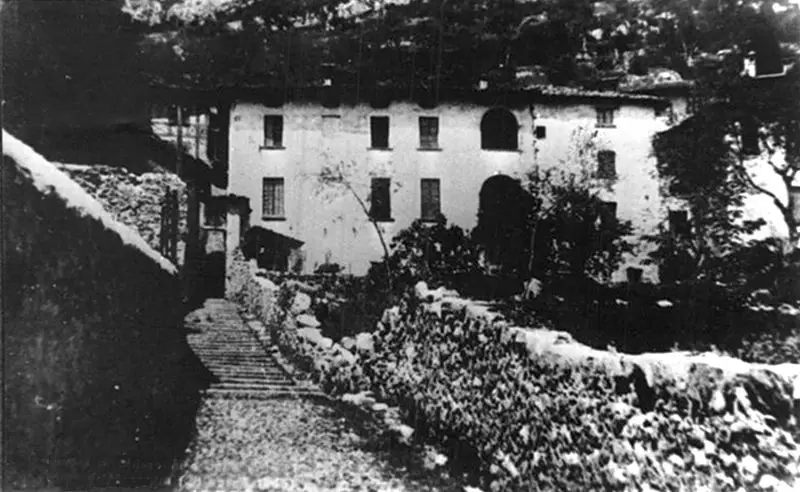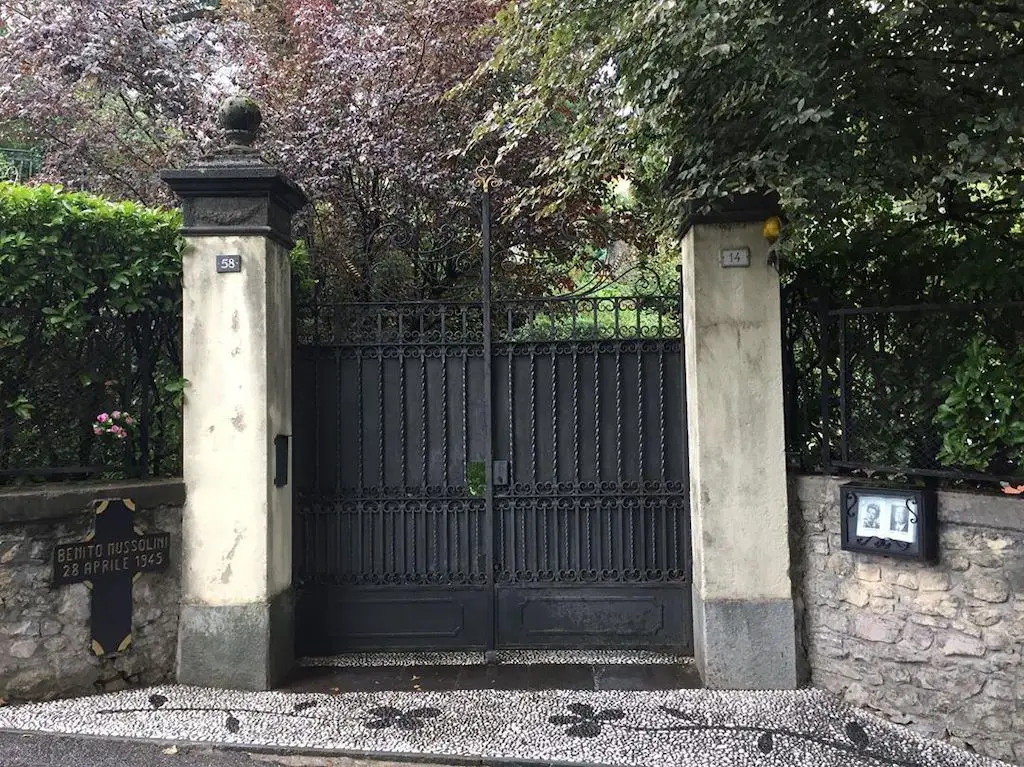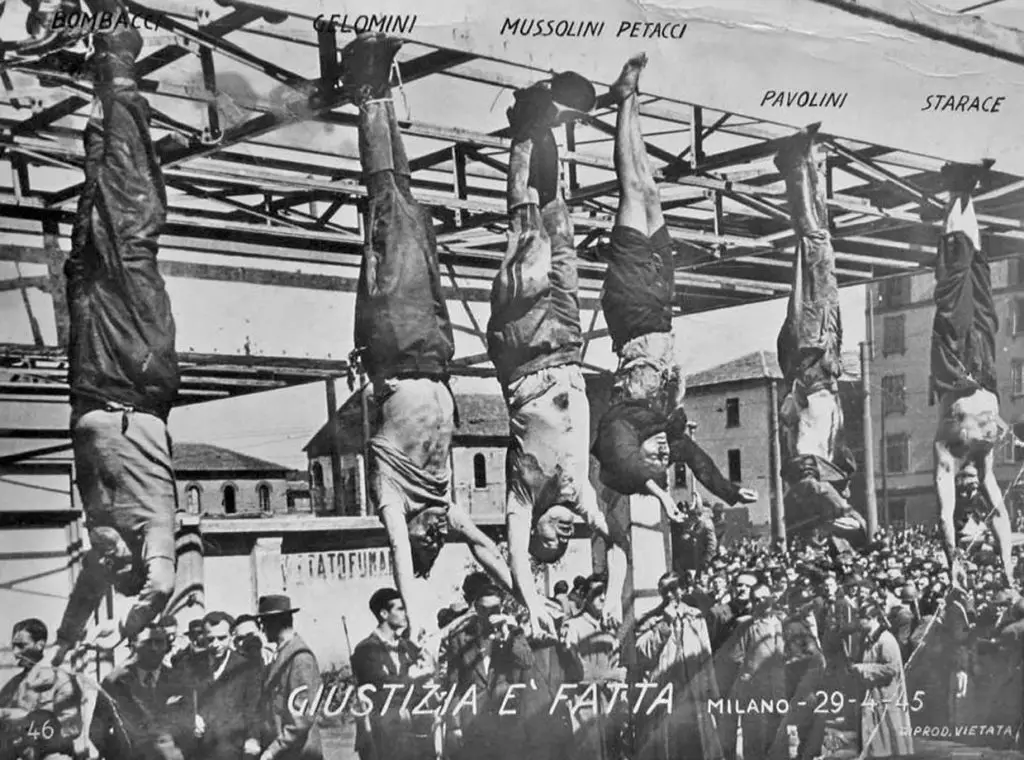On 28 April 1945, Benito Mussolini died. Italian partisans took his body to Milan and exposed it before an angry crowd. Photographs and videos taken on that day have preserved this historic event forever. The whole world quickly learned about Mussolini’s death – even Adolf Hitler, isolated in his Fuhrerbunker. But after 75 years, there is still a question of how Mussolini died and what happened in his final hours. Contradicting witnesses and accounts make finding the truth a difficult task.

Last photo of Mussolini alive, dated 25 April 1945. Here he is abandoning the Prefecture in Milan.
Losing the War
In mid-April 1945, the Allies began their offensive on the Gothic Line, a line the Germans held since October 1944. On the 19th, the German defenses collapsed, and the allies began their final march towards northern Italy.
Related: Benito Mussolini: Rise and Fall of the Italian Dictator
Related: Italian Social Republic: German Puppet State in Northern Italy
Escape
On 18 April 1945, Mussolini arrived in Milan. On the 25th, he accepted a meeting with partisan representatives of the Committee of National Liberation – Northern Italy (CLN-AI ) to discuss terms of his surrender. Hearing only demands of unconditional surrender, Mussolini left the meeting, promising to reply in the afternoon. He never did.
He decided to leave Milan and head north, probably with the intent to cross into neutral Switzerland. A group off S.S. led by Lt. Fritz Brizer (tasked to watch him day and night) and remnants of the Fascist leadership of the Italian Social Republic accompanied the Duce. Clara Petacci later joined him, along with her brother Marcello and his family.
The convoy left Milan and headed north to Lake Como. They brought a considerable number of documents, international banknotes (Italian Liras, Swiss Franks and Pound Sterling), and gold bars. It was a significant horde.
Convoy to Dongo
On the night of 26 and 27 April, the convoy left Como and linked up with a Luftwaffe A.A. company heading north. On the morning of the 27th, the convoy reached a roadblock near the village of Musso. Communist partisans holding the position, led by Commander “Pedro” alias Pier Luigi Bellini delle Stelle, fired a few shots. The Germans did not shoot back and approached the partisans with a white flag. After lengthy negotiations, the partisans allowed the Germans to retreat north under the condition they abandon all Italians traveling with them. Partisans would inspect the convoy at the village of Dongo, the next stop on the road.

“Pedro” Pier Luigi Bellini delle Stelle.
The German failure to challenge the partisans perhaps sealed Mussolini’s fate. The war was lost and nearing an end. German emissaries were already negotiating the surrender of their troops in Italy. They probably saw no reason to waste their lives so close to the end.
On the other hand, the partisans cleverly hid their few numbers behind rocks and vegetation. They gladly agreed to negotiate since the German column could have easily defeated them. Lt. Brizer communicated the terms of the agreement to the fascists. They were removed from the convoy. However, Brizer allowed Mussolini to remain in the convoy disguised as a German soldier. The Duce accepted this situation with reluctance – still holding a bag of important papers.
The Duce Captured
Once the convoy reached Dongo, the partisans inspected the trucks. The young Giuseppe Negri recognized Mussolini and jumped back to report it to the political commissar “Bill” alias Urbano Lazzaro. Not believing Negri’s words, Lazzaro hopped into the truck and made his way to a seemingly sleeping German soldier sitting in the rear.
Urbano Lazzaro recalled stating the following:
I called him. First, I said: “Comrade!” Nothing, no answer. So I said, “Excellency!” Still nothing. So I tried: “Cavalier Benito Mussolini!”. His body shook, like when receiving an electric shock. “He is Mussolini,” I thought. I said to him: “I am arresting you in the name of the Italian people.
They locked Mussolini in a former police post of a nearby village. They kept the other arrested fascist leaders in Dongo. The partisans confiscated the “Treasure” and all their belongings. Captain Neri (AKA: Luigi Canali) stored them in the Dongo City Hall. Captain Neri then instructed his loyal aid “Gianna” (AKA: Giuseppina Tuissi) to make a full inventory of the items confiscated.
During the night, Mussolini moved to various locations, accompanied by Captain Neri, Commander Pedro, Michele Moretti, Gianna, and another two partisans. It appears that they wanted to arrange Mussolini’s transfer to emissaries sent by General Raffaele Cadorna of the CLN-AI.

The De Maria farmhouse, where Petacci and Mussolini spent their last night together. c. 1945. Image: Public Domain.
Hiding the Prisoner
According to the armistice clauses, Mussolini must be captured alive and handed over to the allies. However, the rendezvous never materialized.
Fearing rescue by Fascist loyalists, the partisans subsequently decided to move Mussolini to a farmhouse in Bonzanigo di Mezzegra near Dongo. At this point, they reunited him with Clara Petacci. Two partisans guarded them while Neri, Gianna, and Petro went back to Dongo.
Here is where the verified facts end and questions about Mussolini’s death begin.
Official Account of Mussolini’s Death
During the night of 27 April, members of the CLN-AI unwilling to hand over Mussolini to the Allies, informally decided to dispatch a group of partisans to Dongo on a secret mission to execute Mussolini. The protagonists of this decision were the Socialist Sandro Pertini, the future President of the Republic, and the Communist Luigi Longo, the future secretary of the Italian Communist Party.
On the morning of the 28th, Colonel Valerio (AKA: Walter Audisio) and Aldo Lampredi, a special envoy of the Communist Party, accompanied by 15 other partisans, departed Milan and arrived in Dongo in the early afternoon. Michele Moretti then escorted Valerio and Lampredi to the farmhouse where he and the others left Mussolini the night before. They drove Mussolini to the village of Giulino de Mezzegra and ordered the formation of roadblocks at the two entry points leading to Villa Belmonte.

The brick wall in front of Villa Belmonte. The plaque on the left shows where Mussolini died.
Around 4:00 PM, the group stopped in front of Villa’s entrance. Commander Valerio ordered Mussolini to stand near the wall. He then pronounced Mussolini’s death sentence and fired his weapon. The gun jammed, so he borrowed Moretti’s French MAS-38 submachine gun and fired. The bullets ripped through Mussolini and Claretta Petacci, who jumped in between the Duce and his executioner. The partisans loaded their corpses on a truck and drove down to Dongo.
At Dongo, the truck collected the bodies of the other 15 fascists that fled Milan with Mussolini. Other partisans executed them at around the same time. After dropping the corpses off in Milan, the macabre show of Piazzale Loreto unfolded.

Nobody Claims Credit
This account is the so-called “official version” or “historical version.” L’Unità, a communist newspaper, published this event between November-December 1945. However, the report did not list an author. It was published with a simple introduction by Luigi Longo with no mention of the true identities of the executioners. The report only states the battle name “Commander Valerio.”. It wasn’t until 1947 when the Italian Communist Party confirmed Colonel Valerio is Walter Audisio.
Discrepancies of the Official Version
The memoirs of the three men who allegedly witnessed the execution are quite contradictory. They describe Mussolini’s behavior, just seconds before the shooting, in three separate ways.
- Lampredi did not recall Audisio pronouncing the death sentence, but the Duce asked to be shot in the heart.
- Moretti claimed that Mussolini stated “Viva l’Italia” before being shot.
- Audisio claims Mussolini was frightened and said nothing prior to his execution.

Colonel Valerio (AKA: Walter Audisio) claims to be responsible for Mussolini’s death.
In 1993 Urbano Lazzaro “Bill” claimed that the man who presented himself as Colonel Valerio on that day was not Walter Audisio but Luigi Longo.
In the early 1990s, Dorina Mazzola, who was a young girl residing at Bonzanigo di Mezzegra in 1945, testified that a man and a woman were killed on the morning of the 28th around 11:00 AM, not 4:00 PM. She also recalled one man had a camera with him.
Alternative Version: British Hypothesis
Starting in the early 1990s, a series of researches, memoirs, publications, and testimonies began challenging the official version of the execution. This new narrative claims the order to execute the Duce came from a group of partisans led by a British officer named “Captain John.” The British Hypothesis gained ground thanks to the work of Luciano Garibaldi, a former U.S. agent in Italy named Peter Tompkins, and the testimony of Bruno Giovanni Lonati.
Lonati, a former partisan, stated in 1994 that he shot Mussolini on the orders of “Captain John.” According to this version, Lonati, John, and three other partisans left Milan on the afternoon of the 27th and arrived at the Farmhouse in Bonzanigo di Mezzegra the next morning.
At the Farmhouse, the group managed to disarm the partisans guarding Mussolini and took the Duce and Claretta outside. Lonati recalled that John needed to retrieve important documents that the Duce had with him. However, those documents were already in the hands of the partisans in Dongo.
Captain John said that Mussolini must be executed. Petacci too, because she knew about the papers and must also be eliminated. At approximately 11:00 AM, Lonati shot Mussolini and Captain John shot Petacci. The British officer subsequently took some pictures of the bodies. They then covered the corpses with blankets. At this point, John declared the mission complete and renewed the group’s oath to keep their actions a secret for 50 years.
-
Cover up
According to this theory, the group led by Colonel Valerio would have arrived on the scene soon afterward only to realize that unknown hands already killed Mussolini. They immediately stage a cover-up operation and create a “fake execution” at Villa Belmonte, to publicly claim that CLN-AI envoys executed the Duce.
In support of this theory, Tompkins recalled the testimony of partisan Roberto Remund, one of the men who loaded the corpses on the truck for Milan. Remund remembers that when he arrived in front of Villa Belmonte, he saw no trace of blood, and Mussolini’s body was already rigid. The rigor mortise indicated the execution took place hours and not minutes earlier.
The Papers
The British wanted Mussolini dead because of his papers. But what were these papers? Allegedly, the papers contain a series of letters exchanged with Churchill prior to, and during, the war. These papers contained very sensitive information for which the Duce must be silenced.
The papers most likely contained information about two secret meetings he had with British envoys in September 1944 and January 1945. Peter Tompkins reported this meeting, which Pietro Carradori, Mussolini’s personal attendant, also confirmed.
Speculation and theories continue to circulate about the content of these papers, which unfortunately have disappeared.
Aftermath
What happened in his final hours may never be known. But here are some statements and facts following Mussolini’s death, which may spark additional questions.
- After completing the inventory of the fascist “treasure” in Dongo, Captain Neri transferred it into the custody of Dante Gorreri, a local communist leader. In early May 1945, Captain Neri and Gianna were assassinated. Their bodies remain undiscovered, and the whereabouts of the treasure is unknown.
- In September 1945, private citizen Winston Churchill took a vacation in Italy. He stayed in the same specific area of Lake Como, the side facing Dongo.
- According to the U.S. agent, Peter Tompkins, in September 1945, Dante Gorreri met with a British officer in Como to hand over a set of papers in exchange for 2.5 million lire.
- In his 1997 book, Massimo Caprara, a former assistant of communist leader Palmiro Togliatti, claimed Dante Gorreri transferred the Dongo treasure to a high ranking official of the Communist Party. After that, the party used the money to purchase its new national headquarters in Rome and to finance political activities.
Sources
Tompkins P., Dalle carte segrete del duce, Il saggiatore (2001)
Garibaldi L., La pista inglese, ARES (2002)
Lampredi A., Così fucilammo Mussolini (1972).
Taylor B., The Killing of Il Duce, Warfare History Network (2017).
Messina D., Corriere della Sera (2015)
Alessiani A., Il teorema del verbale 7241, L’autopsia di Mussolini (1990).
Tompkins P., Forenza M.L., Mussolini: ultima verità, RAI (2010).
Bisiach G., Testimoni oculari, RAI (1977).